
There are several options when your loved one needs home care. Cleveland, OH has several local agencies that offer home health and in-home senior care. These organizations keep older people active, healthy, independent, and provide them with legal assistance, transportation, nutrition programmes, and health care insurance counseling.
Comfort Keepers Ohio offers in-home non-medical care for seniors across Cleveland, Ohio. Their CAREGivers are trained to help their clients perform a wide range of daily tasks and live as independently as they can. CAREGivers meet with clients to develop a customized care plan.
They will also drive their clients for appointments and scheduled errands to keep them safe at home. In addition to the basic personal care they provide, CAREGivers can also prepare and serve meals to their clients.
The Visiting Angels franchise model allows CAREGivers to travel across Cleveland, Ohio and surrounding areas, providing care to clients in their homes or in assisted living facilities. This business can be a lucrative opportunity for CAREGivers, who like the idea of being their boss and working in a familiar place.

Visiting Angels has a long-standing, well-recognized brand and provides homecare in many states, including Ohio. They have a track record of providing clients with quality in-home services.
They are a leading provider of in-home care, and their CAREGivers have received extensive training on how to deliver the best home health care to their clients. The CAREGivers are known for the attention they pay to details and their ability adapt to the clients' needs.
Their staff members will meet their clients and customize a care program that meets their specific social and medical needs. The staff can arrange for a professional nurse to provide medical care in the home of their client.
Prices of home care vary based on the services offered. Generally, a home health agency will charge more for care that is provided by a licensed nurse. This is because nurses can provide more advanced medical treatment than a clerical aid.
Medicare pays for most home health care. Check your insurance policy to see if it covers home health care. Some private insurers, and some Medicare supplements insurance policies, cover all or part of the costs of in-home health care.

Your state may also offer a program to help pay for home health care, such as the Ohio Home Care Waiver, which covers certain long-term nursing care costs. This waiver reduces the cost for in-home health services by 50% depending on your age and income.
Choose the right homecare company to ensure your family's well-being and peace of mind. Always check credentials before hiring a home care service. Inquire about background checks, references, policies and how the company handles medical emergencies.
FAQ
What will happen to the health care industry if Medicare is eliminated?
Medicare is an entitlement program that provides financial assistance to low-income individuals and families who cannot afford their premiums. This program is available to more than 40 millions Americans.
Without this program, millions of Americans would lose coverage because some private insurers would stop offering policies to those with pre-existing conditions.
How can I ensure that my family has access health care of the highest quality?
Your state will probably have a department of health that helps ensure everyone has access to affordable health care. There are programs that cover low-income families and their children in some states. For more information, please contact the Department of Health in your state.
What are the three levels of health care facilities?
First, there are general practice clinics that provide basic medical care for patients who don't need hospital admission. If necessary, they may refer patients to other providers. This can include nurse practitioners, general practitioners, and midwives.
Primary care centers are the second level, which provide comprehensive outpatient care and emergency treatment. These include hospitals.
The third level are secondary care centers, which offer specialist services such eye surgeries, orthopedic surgery, and neurosurgery.
Statistics
- For the most part, that's true—over 80 percent of patients are over the age of 65. (rasmussen.edu)
- Price Increases, Aging Push Sector To 20 Percent Of Economy". (en.wikipedia.org)
- The health share of the Gross domestic product (GDP) is expected to continue its upward trend, reaching 19.9 percent of GDP by 2025. (en.wikipedia.org)
- Foreign investment in hospitals—up to 70% ownership- has been encouraged as an incentive for privatization. (en.wikipedia.org)
- For instance, Chinese hospital charges tend toward 50% for drugs, another major percentage for equipment, and a small percentage for healthcare professional fees. (en.wikipedia.org)
External Links
How To
What are the 4 Health Systems?
The healthcare system is complex and includes many organizations, such as hospitals, clinics. pharmaceutical companies. insurance providers. government agencies. public health officials.
The goal of this infographic was to provide information to people interested in understanding the US health care system.
These are some key points.
-
Healthcare spending is $2 trillion annually, representing 17% of the GDP. It's nearly twice the size as the entire defense budget.
-
Medical inflation reached 6.6% in 2015, which is more than any other consumer group.
-
Americans spend on average 9% of their income for health care.
-
There were more than 300 million Americans without insurance as of 2014.
-
Although the Affordable Care act (ACA) was signed into law, its implementation is still not complete. There are still gaps in coverage.
-
A majority of Americans believe that the ACA should continue to be improved upon.
-
The US spends a lot more money on healthcare than any other countries in the world.
-
Affordable healthcare for all Americans would reduce the cost of healthcare by $2.8 trillion per year.
-
Medicare, Medicaid, or private insurance cover 56%.
-
There are three main reasons people don't get insurance: not being able or able to pay it ($25 billion), not having the time ($16.4 billion) and not knowing about it ($14.7 trillion).
-
There are two types of plans: HMO (health maintenance organization) and PPO (preferred provider organization).
-
Private insurance covers the majority of services including doctors, dentists and prescriptions.
-
The public programs cover outpatient surgery as well as hospitalizations, nursing homes, long term care, hospice, and preventive health care.
-
Medicare is a federal program which provides senior citizens with coverage for their health. It covers hospital stays, skilled nursing facility stay, and home healthcare visits.
-
Medicaid is a joint state-federal program that provides financial assistance to low-income individuals and families who make too much to qualify for other benefits.